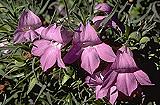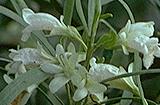|
[Front Page] [Features] [Departments] [Society Home] [Subscribe]

Eremophila and Pollinators
Colin Jennings
Eremophilas are not only adapted to their arid/semi-arid environment but are also adapted to specific pollinators, which is perhaps one of the reasons why so few fruits found in garden situations contain viable seed. The situation is not that much better in the wild at times, and this can possibly be attributed to the seasons, lack of pollinators or a combination of both factors.
Approximately 75% of eremophilas are insect pollinated (entomophilous), with the remainder being bird pollinated (ornithophilous), or adapted for pollination by either.
Eremophilas have flowers which generally are described as being tubular; in fact the common name for many of the species has the word "Fuchsia" included. and we all know how tubular the flowers of that genus are.
Eremophilas which have long tubular segments are as a rule often coloured red, orange, yellow, brown or green, which is within that part of the spectrum mainly used by birds in their detection of suitable food sources, chiefly nectar. The single upper 'lip' which is often four lobed, and the usually narrow lower 'lips' are strongly recurved, as is seen in E.decipiens, E.duttoni, E.glabra etc. The flowers are sometimes spotted; although this is sometimes random and irregular, as in E.maculata and E.alternifolia. The sepals are often large and brightly coloured, which allows for the flowers to be seen by the birds at a distance - an example is E.miniata. Such flowers are generally without any noticeable scent. Hairs within the tube are not very large or obvious.
Nectaries are generally at the basal end of the tube, and in their effort to extract the rich sugary nectar from them, birds disturb pollen from the strategically located stamens, leaving with a dusting on their napes. In most cases the stamens are strongly exserted, which also enables the pollen to be transferred easily. On visiting the next flower the transfer of some of this pollen is made to the stigma: pollination is complete and if all is favourable, germination of the pollen grain occurs and ultimately fertilisation of the ovules within the inferior ovary takes place - and seeds result.
Insects are the vectors responsible for the pollination of those eremophilas which have much shorter tubes, and which in general have flower colours ranging from the blue to violet end of the spectrum and include white - insects are also able to make use of the ultra-violet (a region of the spectrum with shorter wavelength than the visible, outside of the human visible limit), which is understood to be very important in the targeting by insects of their food sources.
 |
 |
|
Two insect-pollinated species showing the short floral tube, 2-lobed upper lip and the three lower lips: Eremophila spectabilis, left (47k); Eremophila mitchellii, right (37k)
Photos: Colin Jennings and Keith Townsend |
|
The insect pollinated flowers usually have a bifid upper 'lip' with the three lower ones lobed, often with the centre one wide and flat, making a suitable landing site for the insects. The stamens are often crossed or hooked across the opening or inside the throat of the corolla, this ensures that as the insect makes its way to the nectary, it must brush past them. In some species the hairs are so dense that the insect must struggle to enter the tube, thus ensuring some pollen transfer. Hairs seem to be variable, yet occur in tufts when they exist, as in E.willsii. The segments sometimes have quite well defined streaking along the lateral walls, and if spotted have the spots rather strategically arranged in bands or along the lateral walls to attract the insects to the centre of the flower. This can be noticed in E.foliosissima where spotting appears in the tube and E.elderi in which banding is seen.
A further refinement of this group, in sub-genus Pholidia, is that there is often patterning or spotting on the throat, which by contrast with the insect pollinated group, is quite regular and the lines and dots are there to ensure that the insect treads the 'straight and narrow'. It is most interesting to look at photographs of flowers taken with film sensitive to UV light: quite amazing 'tracks and paths' appear, which are otherwise invisible to the human eye. Of further interest is the fact that the spotting on the bird pollinated flowers is not activated in UV light, yet the spotting in the insect pollinated species is activated in UV light and in addition the hairs are noted to fluoresce in the latter.
The sepals are usually small, green and have no attraction for the insects. Nectar production is generally minimal and the sugar concentration is low. Scent is a feature of a small number, being more noticeable in the evenings when nocturnal insects, such as moths are active; such species are also found to have poorly developed spotting and rely on scent to attract pollinators.
It is also interesting to note that there are also eremophilas which do not fit the colour criteria mentioned above. Some eremophilas are almost white, including E.laanii and the white colour form of E.racemosa, yet these I have seen being regularly visited in my garden by New Holland Honeyeaters. These flowers have elongated corollas and are thus suited to bird pollination. Some of these 'non-descript' types of flowers have stamens which just project to the end of the corolla and are at times slightly crossed - apparently able to make the best of both types of vectors.
Another feature of eremophilas which has attracted some attention is the problem which some growers have experienced with bees damaging their plants. A number of Eremophila species are quite viscid, having a very waxy exudation produced from their new buds, both foliage and flower. This also presents a problem when certain species are cut to take cuttings for propagation, at times methylated spirits has to be used to remove this very sticky 'mess'. Bees are attracted to the waxy substance and in their effort to remove it from the leaves and flowers cause quite severe damage to the flowers, often cutting holes into the side of the flower to get at the material. It is also known that bees attack plants not in flower, so the attraction is not the nectar, but appears to be the exudant alone. The end result is that the plants turn black and often die back at the tips. It has been suggested that the bees are collecting the material as the raw material for the production of propolis, a kind of 'bee glue', a red-coloured resinous substance used to stop up holes in the hives and in the repair of hives. They are also known to collect this sticky material from the buds of other plants. Eremophilas most affected by these attacks include E.abietina, E.vicida and E.sargentii.
Two rather similar species, so far as vegetative features are concerned, are adapted to different pollinators. Eremophila stenophylla is a 'typically' bird pollinated flower, being elongated and tubular, yet E.dalyana has a more flattened tubular form and is insect pollinated.
Collectively, members of the genus have also been referred to as 'emu bushes'. It was popularly thought that the seeds would only germinate if they passed through the gut of an emu. Emus are known to eat the fleshy drupes. Whilst it is well known that the seeds of eremophilas are difficult to germinate, it has been found that fruits collected from the droppings of emus have produced no better, or worse, germination rates than from those fruits which have never been near an emu. Fruits of eremophilas seem to have a chemical inhibitor which may be removed by soaking or ageing or a combination of both. Mechanical abrasion seems to be a significant factor in the presentation of the fruits in the wild to the elements which stimulate germination, often after fire and thunderstorms or associated flooding.
From the newsletter of the Australian Plants Society (South Australia); August 2001.

[Front Page] [Features] [Departments] [Society Home] [Subscribe]
Australian Plants online - December 2001
Association of Societies for Growing Australian Plants
|